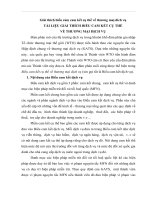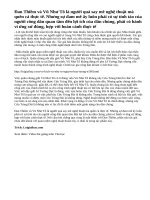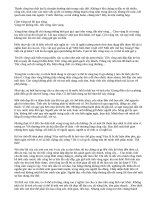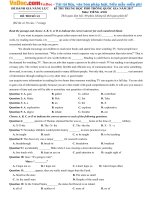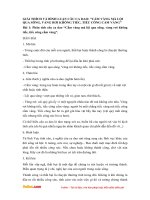GIAI THICH CAM 13 LISTENING
Bạn đang xem bản rút gọn của tài liệu. Xem và tải ngay bản đầy đủ của tài liệu tại đây (664.03 KB, 102 trang )
CAMBRIDGE IELTS 13 Listening– Test 1 – Section 1 ............................................................ 2
CAMBRIDGE IELTS 13 Listening– Test 1 – Section 2 ........................................................... 7
CAMBRIDGE IELTS 13 Listening– Test 1 – Section 3 .......................................................... 13
CAMBRIDGE IELTS 13 Listening– Test 1 – Section 4 .......................................................... 19
CAMBRIDGE IELTS 13 Listening– Test 2 – Section 1 .......................................................... 25
CAMBRIDGE IELTS 13 Listening– Test 2 – Section 2 .......................................................... 30
CAMBRIDGE IELTS 13 Listening– Test 2 – Section 3 .......................................................... 37
CAMBRIDGE IELTS 13 Listening– Test 2 – Section 4 .......................................................... 45
CAMBRIDGE IELTS 13 Listening– Test 3 – Section 1 .......................................................... 51
CAMBRIDGE IELTS 13 Listening– Test 3 – Section 2 .......................................................... 56
CAMBRIDGE IELTS 13 Listening– Test 3 – Section 3 .......................................................... 63
CAMBRIDGE IELTS 13 Listening– Test 3 – Section 4 .......................................................... 70
CAMBRIDGE IELTS 13 Listening– Test 4 – Section 1 .......................................................... 76
CAMBRIDGE IELTS 13 Listening– Test 4 – Section 2 .......................................................... 82
CAMBRIDGE IELTS 13 Listening– Test 4 – Section 3 .......................................................... 89
CAMBRIDGE IELTS 13 Listening– Test 4 – Section 4 .......................................................... 97
Cambridge IELTS 13
Listening
Test 1
Section 1
Questions 1 – 10
Complete the table below.
Write ONE WORD AND/OR A NUMBER for each answer.
COOKERY CLASSES
Cookery Class
Example
Focus
how to 1 ….. and cook
with seasonal products
The Food Studio
Other information
• small classes
• also offers 2
………classes
• clients who return get a 3
….. discount
Bond’s Cookery
School
food that is 4……….
• includes recipes to
strengthen your 5 ….
• they have a free 6 …
every Thursday
The 7….. Centre
mainly 8 ……… food
• located near the 9………
• a special course in skills
with a 10 …. is
sometimes available
1. Here’s what the speaker says:
OFFICIAL: They focus on seasonal products, and as well as teaching you how to
cook them, they also show you how to choose them.
Explanation: the man gave an overview of the cookery class in The Food studio. He
stated its aim clearly: teach people how to choose seasonal products besides the ways
to cook them.
The answer is choose.
2. Here’s what the speakers say:
WOMAN: Anh could I get a private lesson there?
OFFICIAL: I think so… let me check, yes, they do offer those. Those in fact, most
of the people who attended the classes find it’s a nice way of getting to know one
another.
Explanation: The woman asked if there were any private lessons in The Food
Studio. This was confirmed by the official, as he said: “they do offer those” after he
had checked the relevant information.
The answer is private.
3. Here’s what the speaker says:
OFFICIAL: And this company has a special deal for clients where they offer a
discount of 20 percent if you return for a further class.
Explanation: The man states clearly that clients who come back for a further class
will receive a 20 percent discount in cooking classes there.
The answer is 20/twenty percent.
4. Here’s what the speaker says:
OFFICIAL: …Another one you might be interested in is Bond’s Cookery School.
They’re quite new, they just opened six months ago, but I’ve heard good things
about them. They concentrate on teaching you to prepare healthy food, and they
have quite a lot of specialist staff.
Explanation: the official emphasizes that clients are taught how to prepare healthy
food in Bond’s Cookery School.
The answer is healthy.
5. Here’s what the speaker says:
OFFICIAL: Well, I don’t think they particularly focus on low calorie diets or
weight loss. It’s more to do with recipes that look at specific needs, like
including ingredients that will help build up your bones and make them
stronger, that sort of thing.
Explanation: the man explains about the aim of the recipes in the cooking
classes. Rather than offering the clients weight loss meals, the recipes will
address the body’s need like strengthening bones…
The answer is bones.
6. Here’s what the speaker says:
OFFICIAL:…And if you want to know more about them, every Thursday
evening, they have a lecture at the school. It’s free and you don’t need to book
or anything, just turn up at 7.30.
Explanation: the man mentions about a free lecture every Thursday evening in
Bond’s Cookery School.
The answer is lecture.
7. Here’s what the speaker says:
OFFICIAL: OK, there’s one more place you might be interested in. That’s got
a rather strange name, it’s called The Arretsa Centre – that’s spelled A-R-R-ET-S-A.
Explanation: the official mentioned another cookery class called “The Arretsa
Centre.” He then went on spelling the school name for the woman.
The answer is Arretsa.
8. Here’s what the speaker says:
OFFICIAL: They’ve got a very good reputation. They do a bit of meat and fish
cookery but they mostly specialize in vegetarian dishes.
Explanation: the man states that the cooking centre focuses primarily on
vegetarian food.
The answer is vegetarian.
9. Here’s what the speakers say:
WOMAN: Right. That’s certainly an area I’d like to learn more about. I’ve got lots
of friends who don’t eat meat. In fact, I think I might have seen that school today.
Is it just by the market?
OFFICIAL: That’s right. So they don’t have any problem getting their ingredients.
They’re right next door.
Explanation: the woman asked whether the school located near the market she saw
that day was the Arretsa Centre. This was confirmed by the official when he added
“they’re right next door”, “so they don’t have any problem getting their ingredients.”
The answer is market.
10. Here’s what the speaker says:
OFFICIAL: … And they also offer a special two-hour course in how to use a
knife. They cover all the different skills – buying them, sharpening, chopping
techniques. It gets booked up quickly though so you’d need to check it was
available.
Explanation: the man specified a special training course with a knife in the
cooking centre. He then listed some skills taught in the course such as buying
knives, sharpening, chopping techniques.
The answer is knife.
CAMBRIDGE IELTS 13
LISTENING
Test 1
Section 2
Questions 11-13
Choose the correct letter, A, B or C.
11. Why are changes needed to traffic systems in Granford?
A. The number of traffic accidents has risen.
B. The amount of traffic on the roads has increased.
C. The types of vehicles on the roads have changed.
Here’s what the speaker says:
- Well, we’re very aware that the traffic is becoming an increasing problem. It’s
been especially noticeable with the increase in heavy traffic while they’ve been
building the new hospital. But it’s the overall rise in the volume of traffic of all
kinds that’s concerning us. To date, there’s not been any increase in traffic
accidents, but that’s not something we want to see happen, obviously.
Explanation: The speaker mentions the increase in heavy traffic, meaning the types
of vehicles on the roads have changed, but he doesn’t say it is an issue, so C is not
correct. He also says: “To date, there’s not been any increase in traffic accidents”, so
A is wrong, too.
The problem concerning is the overall rise in the amount of traffic, so the answer for
this question is B.
12. In a survey, local residents particularly complained about
A. dangerous driving by parents.
B. pollution from trucks and lorries.
C. inconvenience from parked cars.
Here’s what the speaker says:
- We recently carried out a survey of local residents, and their responses were
interesting. People were very concerned about the lack of visibility on some
roads due to cars parked along the sides of the roads. We’d expected
complaints about the congestion near the school when parents are dropping off
their children or picking them up, but this wasn’t top of the list, and nor were
the noise and fumes from trucks and lorries, though they were mentioned by
some people.
Explanation: A is irrelevant as the speaker only speaks of congestion caused by
parents and makes no reference to “dangerous driving”. “Pollution from trucks and
lorries” is not a main problem either since few people have mentioned about it, so B is
incorrect.
The correct answer is C for “people were very concerned about the lack of visibility
on some roads due to cars parked along the sides of the roads.”
13. According to the speaker, one problem with the new regulations will be
A. raising money to pay for them.
B. finding a way to make people follow them.
C. getting the support of the police.
Here’s what the speaker says:
- We think these new traffic regulations would make a lot of difference… We’ve
managed to keep our proposals within the budget, just, so they can be covered
by the Council. But of course, it’s no good introducing new regulations if we
don’t have a way of making sure that everyone obeys them, and that’s an area
we’re still working on with the help of representatives from the police force.
Explanation: The speaker says new regulations can be covered by the Council, so
they don’t have to raise money to pay for the new rules. Hence, A is false. B is correct
since “it’s no good introducing new regulations if we don’t have a way of making sure
that everyone obeys them.” And they can find a way to make people follow them with
the support of the police: “that’s an area we’re still working on with the help of
representatives from the police force”, so C is incorrect.
The correct answer, therefore, must be B.
Questions 14-20
Label the map below.
Write the correct letter, A-I, next to Questions 14-20.
14. New traffic lights
Here’s what the speaker says:
- Now, we already have a set of traffic lights in the High Street at the junction
with Station Road, but we’re planning to have another set at the other end, at
the School Road junction, to regulate the flow of traffic along the High Street.
Explanation: starting from the High Street, follow the instructions, moving
towards the School Road junction, we reach site E, where the new set of traffic
lights will be positioned.
The answer is E.
15. Pedestrian crossing
Here’s what the speaker says:
- We considered putting this on School Road, just outside the school, but in the
end we decided that could lead to a lot of traffic congestion so we decided to
locate it on the High Street, crossing the road in front of the supermarket.
Explanation: Crossing the High Street until we reach the supermarket, we can
find site D, where the pedestrian crossing will be put.
The answer is D.
16. Parking allowed
Here’s what the speaker says:
- At present, parking isn’t allowed on the High Street outside the library, but
we’re going to change that and allow parking there, but not at the other end of
the High Street near School Road.
Explanation: Now that parking will be allowed on the High Street, outside the
library, it must be located in site B.
The answer is B.
17. New “No Parking” sign
Here’s what the speaker says:
- There’ll be a new ‘No Parking’ sign on School Road, just by the entrance to the
school,…
Explanation: Site G is located just by the entrance to the school, so it must be
where the new ‘No Parking’ sign will lie.
The answer is G.
18. New disabled parking spaces
Here’s what the speaker says:
- As far as disabled drivers are concerned, at present they have parking outside
the supermarket, but lorries also use those spaces, so we’ve got two new
disabled parking spaces on the other side road up towards the bank.
Explanation: Locating the bank on the map, we can find site C next to it. So,
C is where the two new disabled parking spaces will be situated.
The answer is C.
19. Widened pavement
Here’s what the speaker says:
- We also plan to widen the pavement on School Road. We think we can manage
to get an extra half-metre on the bend just before you get to the school, on the
same side of the road.
Explanation: The bend just before you get to the school is marked with letter
H. So, site H must be the widened pavement.
The answer is H.
20. Lorry loading/ unloading restrictions
Here’s what the speaker says:
- Finally, we’ve introduced new restrictions on loading and unloading for the
supermarket, so lorries will only be allowed to stop there before 8 a.m. That’s
the supermarket on School Road – we kept to the existing arrangements with
the High Street supermarket.
Explanation: The supermarket on School Road is marked with letter I.
Therefore, the new restrictions on loading and unloading for the supermarket
will be applied at site I while the old ones are applied to the High Street
supermarket.
The answer is I.
Here's a table showing 'keywords':
Q
11
12
13
Keywords in the question
The amount of traffic on the
roads has increased
complain about
Pollution
make people follow them
support
Similar words in the recording
the overall rise in the volume of traffic
of all kinds
be very concerned about
noise and fumes
make sure that people obeys them
help
CAMBRIDGE IELTS 13
LISTENING
Test 1
Section 3
Questions 21-25
Choose the correct letter, A, B or C.
21. Why is Jack interested in investigating seed germination?
A. He may do a module on a related topic later on.
B. He wants to have a career in plant science.
C. He is thinking of choosing this topic for his dissertation.
Here’s what the speaker says:
JACK: Yeah, but practically everything we do is going to feed into that. No, there’s
an optional module on seed structure and function in the third year that I might do, so
I thought it might be useful for that. If I choose that option, I don’t have to do a
dissertation module.
Explanation: Jack says the assignment may be useful for the module on seed
structure and function that he might do in the third year. The correct answer is A.
22. Jack and Emma agree the main advantage of their present experiment is
that it can be
A. described very easily.
B. carried out inside the laboratory.
C. completed in the time available.
Here’s what the speakers says:
EMMA: OK. We’d need to allow time for the seeds to come up.
JACK: That should be fine if we start now. A lot of the other possible experiments
need quite a bit longer.
EMMA: So that’d make it a good one to choose. And I don’t suppose it’d need much
equipment; we’re not doing chemical analysis or anything. Though that’s not really an
issue, we’ve got plenty of equipment in the laboratory.
Explanation: The question asks about the main advantage of the project. According
to the recording, we know that the experiment won’t need as much time as the others,
meaning its plus point lies in its time. So the answer is C.
23. What do they decide to check with their tutor?
A. whether their aim is appropriate
B. whether anyone else has chosen this topic
C. whether the assignment contributes to their final grade
Here’s what the speaker says:
JACK: Yeah. We need to have a word with the tutor if we’re going to go ahead with it
though. I’m sure our aim’s OK. It’s not very ambitious but the assignment’s only ten
percent of our final mark, isn’t it? But we need to be sure we’re the only ones doing it.
Explanation: Jack says their aim’s OK so A is incorrect. He already knows the
assignment accounts for ten percent of their final mark so C is wrong, too.
The only thing that they need to check with their tutor is whether anyone else has
chosen this topic, “we need to be sure we’re the only ones doing it”. Hence, the
correct answer is B.
24. They agree that Graves’ book on seed germination is disappointing
because
A. it fails to cover recent advances in seed science.
B. the content is irrelevant for them.
C. its focus is very theoretical.
Here’s what the speaker says:
EMMA: The one by Graves? I looked through it for my last experiment, though it
wasn’t all that relevant there. It would be for this experiment, though. I found it quite
hard to follow – lots about the theory, which I hadn’t expected.
Here are some key words that help you to get the correct answer (C):
theoretical = lots about the theory
Explanation: Emma says the book is hard to follow because it contains lots of theory.
This means its focus is very theoretical.
So, the correct answer is C.
25. What does Jack say about the article on seed germination by Lee Hall?
A. The diagrams of plant development are useful.
B. The analysis of seed germination statistics is thorough.
C. The findings on seed germination after fires are surprising.
Here’s what the speakers say:
JACK: I read an article about seed germination by Lee Hall.
EMMA: About seeds that lie in the ground for ages and only germinate after a fire?
JACK: That’s the one. I knew a bit about it already, but not about this research. His
analysis of figures comparing the times of the fires and the proportion of seeds that
germinated was done in a lot of detail – very impressive.
Here are some key words that help you to get the correct answer (B):
thorough = done in a lot of detail
Explanation: There is no mention of the diagrams of plant development in the
recording, hence, A is incorrect. Be careful with the choice C as you mighe be misled
by the words. Although the book focuses on seed germination after fires, there is no
information about the findings of seeds after fires and whether the results are
suprising or not. So, C is incorrect, too.
However, Jack is impressed by the in-depth analysis in the book. Therefore, the
correct answer is B.
Questions 26-30
Complete the flowchart below.
Choose FIVE answers from the box and write the correct letter, A-H, next to
Questions 26-30.
A. container
B. soil
C. weight
D. condition
E. height
F. colour
G. types
H. depths
Stages in the experiment
26. Select seeds of different … and sizes.
Here’s what the speaker says:
JACK: Right. So the first thing we have to do is find our seeds…And obviously they mustn’t all
be the same size. So, how many sorts do we need? About four different ones?
Here are some key words that help you to get the correct answer (G):
types = sorts
Explanation: Jack says they should select seeds from four different types (“sorts”)
and sizes.
The answer is G. types.
27. Measure and record the … and size of each one.
Here’s what the speaker says:
JACK: Then, for each seed we need to find out how much it weighs, and also measure its
dimensions, and we need to keep a careful record of all that.
Here are some key words that help you to get the correct answer (C):
weight = how much it weighs
Explanation: Jack says they need to record the weight (“find out how much it
weighs”) and size of every seed.
The answer is C. weight.
28. Decide on the … to be used.
Here’s what the speaker says:
EMMA: That’ll be quite time-consuming. And we also need to decide how deep we’re going to
plant the seeds – right on the surface, a few millimetres down, or several centimetres.
Here are some key words that help you to get the correct answer (H):
depths = how deep
Explanation: Emma says they need to determine the depths (“how deep”) they will
plant the seeds.
The answer is H. depths.
29. Use a different … for each seed and label it.
Here’s what the speakers say:
JACK: OK. So then we get planting. Do you think we can plant several seeds together in the
same plant pot?
EMMA: No, I think we need a different one for each seed.
JACK: Right. And we’ll need to label them – we can use different coloured labels…
Here are some key words that help you to get the correct answer (A):
container = plant pot
Explanation: Emma thinks they should use different containers (“plant pots”) for
each seed.
The answer is A. containers.
30. After about 3 weeks, record the plant’s …
Here’s what the speaker says:
JACK: … Then we wait for the seeds to germinate – I reckon that’ll be about three weeks,
depending on what the weather’s like. Then we see if our plants have come up, and write down
how tall they’ve grown.
Here are some key words that help you to get the correct answer (E):
height = how tall
Explanation: Jack says after about 3 weeks, they’ll record the height (“how tall”) of
the plant.
The answer is E. height.
Here's a table showing 'keywords':
Q
24
25
26
27
28
29
30
Keywords in the question
theoretical
Thorough
types
weight
depths
container
height
Similar words in the recording
lots about the theory
done in a lot of detail
sorts
how much it weighs
how deep
plant pot
how tall
CAMBRIDGE IELTS 13
LISTENING
Test 1
Section 4
Questions 31-40
Complete the notes below.
Write ONE WORD ONLY for each answer.
Effects of urban environments on animals
Introduction
Recent urban developments represent massive environmental changes. It was
previously thought that only a few animals were suitable for city life, e.g.
• The 31 … - because of its general adaptability
• The pigeon – because walls of city buildings are similar to 32 …
In fact, many urban animals are adapting with unusual 33 …
Recent research
• Emilie Snell-Rood studied small urbanized mammal specimens from museums
in Minnesota.
- She found the size of their 34 … had increased.
- She suggests this may be due to the need to locate new sources of 35…
and to deal with new dangers.
• Catarina Miranda focused on the 36 … of urban and rural blackbirds.
- She found urban birds were often braver, but were afraid of situations
that were 37 …
• Jonathan Atwell studies how animal respond to urban environments.
- He found that some animals respond to 38 … by producing lower levels
of hormones.
• Sarah Partan’s team found urban squirrels use their 39 … to help them
communicate.
Long-term possibilities
Species of animals may develop which are unique to cities. However, some changes
may not be 40 …
31. Here’s what the speaker says:
- …And we used to think that only a few species could adapt to this new
environment. One species which is well-known as being highly adaptable is the crow,
and there’ve been various studies about how they manage to learn new skills.
Here are some key words that help you to get the correct answer (crow):
adaptability = adaptable
Explanation: the speaker talks about one species that is easily adaptable to the new
environment, so the answer is crow.
32. Here’s what the speaker says:
- Another successful species is the pigeon, because they’re able to perch on ledges on
the walls of city buildings, just like they once perched on cliffs by the sea.
Explanation: The speaker likens ledges on the walls of city buildings to cliffs by the
sea, where the pigeon usually perch on. So, the answer is cliffs.
33. Here’s what the speaker says:
- …And one thing that researchers are finding especially interesting is the speed with
which they’re doing this – we’re not talking about gradual evolution here – these
animals are changing fast.
Here are some key words that help you to get the correct answer (speed):
unusual speed = changing fast
Explanation: the speaker highlights the high speed with which animals are changing
to adapt to urban environments. Hence, the answer is speed.
34. Here’s what the speaker says:
- …And she found that during that time, these small mammals had experienced a
jump in brain size when compared to rural mammals.
Here are some key words that help you to get the correct answer (brain):
a jump = increased
Explanation: In the recording, Emilie Snell-Rood found an increase in the size of the
animals’ brain. So, the answer is brain.
35. Here’s what the speaker says:
- And Snell-Rood thinks that this change might reflect the cognitive demands of
adjusting to city life – having to look in different places to find food, for example, and
coping with a whole new set of dangers.
Here are some key words that help you to get the correct answer (food):
locate = look in different places to find
deal with = cope with
Explanation: The speaker suggests that the change in the animals’ brain size may be
due to their locating (“look in different places to find”) new sources of food. So, the
answer is food.
36. Here’s what the speaker says:
- Then over in Germany at the Max Planck Institute, there’s another biologist called
Catarina Miranda who’s done some experiments with blackbirds living in urban and
rural areas. And she’s been looking not at their anatomy but at their behaviour.
Explanation: It is stated clearly in the recording that Catarina Miranda focused on
the behaviour of blackbirds living in urban and rural areas, not on their bodies.
So, the answer is behaviour.
37. Here’s what the speaker says:
- … She’s found that the urban blackbirds tend to be quite bold – they’re prepared to
face up to a lot of threats that would frighten away their country counterparts. But
there’s one type of situation that does seem to frighten the urban blackbirds, and that’s
anything new – anything they haven’t expected before.
Here are some key words that help you to get the correct answer (new):
afraid of = frighten = frighten away
braver = bold
Explanation: According to the tape, while the urban blackbirds are usually braver
than their rural counterparts, they are afraid of “anything new – anything they haven’t
expected before”. So the answer must be “new”.
38. Here’s what the speaker says:
- Jonathan Atwell, in Indianna University, is looking at how a range of animals
respond to urban environment. He’s found that when they’re under stress, their
endocrine systems react by reducing the amount of hormones such as corticosterone
into their blood.
Here are some key words that help you to get the correct answer (stress):
Lower levels of hormones = reducing the amount of hormones
Explanation: The speaker talks about a situation in which animals respond by
producing lower levels of hormones. From the evidence above, the situation must be
“stress”. So the answer is “stress”.
39. Here’s what the speaker says:
- There’s just one more study I’d like to mention which is by Sarah Partan and her
team, and they’ve been looking at how squirrels communicate in an urban
environment, and they’ve found that a routine part of their communication is carried
out by waving their tails.
Explanation: The study conducted by Sarah Partan’s team suggested that urban
squirrels use their tails to communicate with one another. So the answer is “tails”.
40. Here’s what the speaker says:
- So, what are the long-term implications of this? One possibility is that we may see
completely new species developing in cities. But on the other hand, it’s possible that
not all of these adaptations will be permanent.
Here are some key words that help you to get the correct answer (permanent):
changes = adaptations
Explanation: It’s clearly indicated in the speaker’s conclusion that the adaptations
developed by the urban animals may not be permanent ones. So the answer for this
question is “permanent”.
Here’s a table showing keywords:
Q
31
33
34
35
37
38
40
Keywords in the question
adaptability
unusual speed
a jump
locate
deal with
afraid of
Braver
lower levels of hormones
changes
Similar words in the recording
adaptable
changing fast
increased
look in different places to find
cope with
frighten = frighten away
bold
reducing the amount of hormones
adaptations
Cambridge IELTS 13
Listening
Test 2
Section 1
Questions 1 – 10
Complete the table below.
Write ONE WORD AND/OR A NUMBER for each answer.
South City Cycling Club
Example
Name of club secretary: Jim Hunter
Membership
•
•
•
•
Full membership costs $260; this covers cycling and 1 … all over Australia
Recreational membership costs $108
Cost of membership includes the club fee and 2 …
The club kit is made by a company called 3 …
Training rides
• Chances to improve cycling skills and fitness
• Level B: speed about 4 ….kph
• Weekly sessions
- Tuesdays at 5.30 am, meet at the 5 …
- Thursday at 5.30 am, meet at the entrance to the 6 …
Further information
• Rides are about an hour and a half
• Members often have 7 … together afterwards
